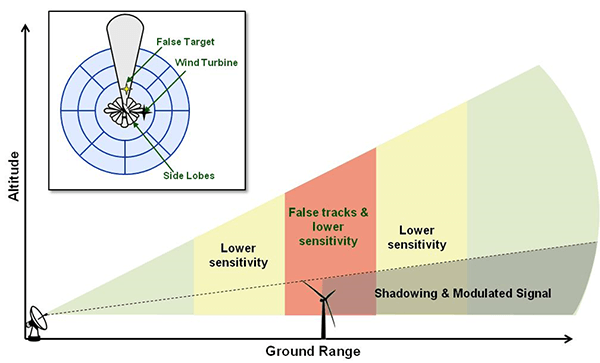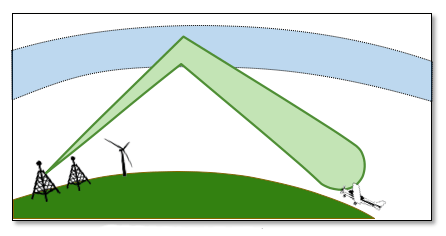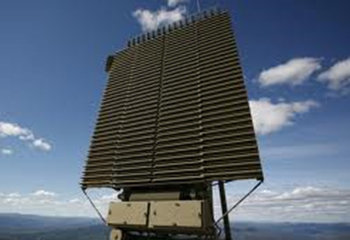Wind Plants & Radar Interactions:
Understanding Impacts & Mitigation Strategies

Wind Energy & Avian Species:
Understanding Impacts & Mitigation Strategies



OFFICE OF ENERGY EFFICIENCY & RENEWABLE ENERGY
-
Wind energy is one of the fastest-growing sources of new electricity supply in the United States.
-
As wind development continues to increase and projects are constructed in areas that were previously undeveloped, wind turbines have the potential to create interference with our nation's radar systems.
-
The following slides provide information about wind turbine radar interference and the strategies that help to minimize and mitigate these interactions.
Cedar Creek Wind Plant in Grover, Colorado.
Photo by Dennis Schroeder,
NREL 31195
U.S. DEPARTMENT OF ENERGY
2
Wind Plants & Radar Interactions: Understanding Impacts & Mitigation Strategies
Introduction

OFFICE OF ENERGY EFFICIENCY & RENEWABLE ENERGY
The following slides provide an overview of:
- Wind-radar interference basics
- Different radar systems
- Early coordination and information review with federal agencies to prevent interference issues
- The Wind Turbine Radar Interference Mitigation Working Group and interagency strategy to address wind-radar issues
- Public tools to determine potential impact prior to mandatory reviews
- Formal Federal Aviation Administration (FAA) and Department of Defense (DOD) project review processes
- Mitigation options.
Aerial photo of the Colorado Green Wind Plant.
Photo by Michael Milligan,
NREL 13358
U.S. DEPARTMENT OF ENERGY
3
Wind Plants & Radar Interactions: Understanding Impacts & Mitigation Strategies
Introduction (cont.)

OFFICE OF ENERGY EFFICIENCY & RENEWABLE ENERGY
-
Wind turbines are large structures with both stationary and moving parts. 1
-
Turbines can cause interference if located within radar line of sight.
-
Turbines have potential for electromagnetic reflectivity that can impact radars. 2
-
With a tip speed of up to 200 knots 1 (~230 mph), turbine blades rotate fast enough for radar to sense them as moving objects. 3
- When mitigation measures are not employed, radar performance can be degraded due to interference from wind turbines, decreasing the probability of detection by the system, generating false targets, and obstructing target tracking. 4
1. Sandia National Laboratories.
Siting: Wind Turbine/Radar Interference Mitigation (TSPEAR & IFT&E).
2. U.S. Department of Energy.
Federal Interagency Wind Turbine Radar Interference Mitigation Strategy. January 2016.
3. Sandia National Laboratories.
Interagency Field Test & Evaluation Industry Report: Wind Turbine-Radar Interference Test Summary. September 2014.
4. WINDExchange.
Overcoming Wind Siting Challenges II: Radar: A WINDExchange Webinar. April 2015.
U.S. DEPARTMENT OF ENERGY
4
Wind Plants & Radar Interactions: Understanding Impacts & Mitigation Strategies
Wind Turbine-Radar Interference Basics
OFFICE OF ENERGY EFFICIENCY & RENEWABLE ENERGY
Project stakeholders or policymakers may have concerns about:
-
Flight safety (FAA)
-
Homeland security (Department of Homeland Security, or DHS)
-
Homeland defense (DOD)
-
Weather observation (National Oceanic and Atmospheric Administration, or NOAA).
Images courtesy of Massachusetts Institute of Technology Lincoln Laboratory
U.S. DEPARTMENT OF ENERGY
5
Wind Plants & Radar Interactions: Understanding Impacts & Mitigation Strategies
Wind-Radar Interference Basics (cont.)

OFFICE OF ENERGY EFFICIENCY & RENEWABLE ENERGY
-
Beam properties
-
Signal propagation
-
Clutter rejection techniques
-
Range resolution
-
Altitude resolution
-
Doppler resolution.
Images courtesy of Massachusetts Institute of Technology Lincoln Laboratory
U.S. DEPARTMENT OF ENERGY
6
Wind Plants & Radar Interactions: Understanding Impacts & Mitigation Strategies
Different radars have different characteristics.


To learn more about radar characteristics, see the Massachusetts Institute of Technology Lincoln Laboratory’s Introduction to Radar Systems online course.

OFFICE OF ENERGY EFFICIENCY & RENEWABLE ENERGY
-
The DOD Siting Clearinghouse works with industry to overcome risks to national security while promoting compatible domestic energy development.
-
The DOD has formal and informal procedures in place to ensure federal agencies are notified and impact studies are completed prior to the construction of a wind energy project.
-
Developers can coordinate an early review with the DOD/FAA.
-
The early review process provides a timely, transparent, and science-based analysis of potential impacts to military operations. Once impacts are identified, the DOD works to identify mitigation strategies to minimize those impacts.
-
Some states have incorporated notifying DOD about proposed energy projects into their requirements.
U.S. DEPARTMENT OF ENERGY
7
Wind Plants & Radar Interactions: Understanding Impacts & Mitigation Strategies
Early coordination with the FAA, NOAA, DHS, and DOD's Siting Clearinghouse during the siting process can help prevent an interference issue long before a facility is built.
OFFICE OF ENERGY EFFICIENCY & RENEWABLE ENERGY
-
The MOU's purpose is to mitigate the technical and operational impact of wind turbine projects on critical radar missions.
-
The MOU establishes a framework of cooperation and coordination among DOD, the U.S. Department of Energy (DOE), FAA, and NOAA, with DHS as an observer.
-
It establishes the Wind Turbine Radar Interference Mitigation Working Group, a follow-on to the Interagency Field Test & Evaluation Program.
-
The MOU's goals are to develop near- (5 years), mid- (10 years), and long-term (20 years) mitigation solution recommendations. These will be primarily technology driven but will also extend to policy and legislative proposals as necessary.
U.S. DEPARTMENT OF ENERGY
8
Wind Plants & Radar Interactions: Understanding Impacts & Mitigation Strategies
A 2014 memorandum of understanding (MOU) outlines a path to further minimize wind turbine radar interference, establishing a framework of agency coordination.

U.S. Department of Energy. Federal Interagency Wind Turbine Radar Interference Mitigation Strategy. January 2016.
OFFICE OF ENERGY EFFICIENCY & RENEWABLE ENERGY
U.S. DEPARTMENT OF ENERGY
9
Wind Plants & Radar Interactions: Understanding Impacts & Mitigation Strategies
Federal Interagency Wind Turbine Radar Interference Mitigation Strategy: By 2025, eliminate wind turbine radar interference as an impact to critical radar missions, ensure the long-term resilience of radar operations in the presence of wind turbines, and remove radar interference as an impediment to future wind energy development.
Images courtesy of Massachusetts Institute of Technology Lincoln Laboratory



Sandia National Laboratories Tool for Siting, Planning, and Encroachment Analysis for Renewables (TSPEAR)
Massachusetts Institute of Technology Lincoln Laboratory Increased Range Resolution Algorithm
Spectrum Efficient National Surveillance Radar (SENSR) Wind Turbine Specifications Development
Strategic Theme 1:
Improve capacity to evaluate the impacts of wind energy on sensitive radars
Strategic Theme 2:
Develop and deploy mitigation measures to increase resilience of existing radars to wind turbines
Strategic Theme 3:
Encourage the development of next-generation radars resistant to wind turbine interference
OFFICE OF ENERGY EFFICIENCY & RENEWABLE ENERGY
U.S. DEPARTMENT OF ENERGY
10
Wind Plants & Radar Interactions: Understanding Impacts & Mitigation Strategies
Developers can use public agency screening tools to help determine potential impact prior to mandatory reviews.
Graphic examples of airspace and system capability constraints that can be impacted by wind turbine radar interference. In the first image, the Special Use Airspace is indicated by the blue shaded areas. In the second image, military flight routes are indicated by the yellow areas. Graphic by Bryan Miller, Sandia National Laboratories contractor
The DOD Preliminary Screening Tool enables developers to obtain a preliminary review of potential impacts to Long-Range and Weather Radar(s), Military Training Route(s), and Special Airspace(s) prior to official FAA filing processes.

OFFICE OF ENERGY EFFICIENCY & RENEWABLE ENERGY
U.S. DEPARTMENT OF ENERGY
11
Wind Plants & Radar Interactions: Understanding Impacts & Mitigation Strategies
NEXRAD Screening Tool snapshots, including an area around a NEXRAD in Fort Drum, New York
NOAA's Public NEXRAD Screening Tool enables developers to obtain a preliminary review of potential impacts to weather radars prior to an official FAA filing.
The Tool contains map layers that users can view:
- NOAA NEXRAD Weather Radars, including the:
- 4-km No-Build Zone (red)
- Mitigation Zone (orange; area in which a solution must be incorporated)
- Consultation Zone (yellow; developers should consult with NOAA Radar Operations Center)
- Notification Zone (green; OK to build but notify NOAA Radar Operations Center)
- Wind Plants (dark blue)
- Terminal Doppler weather radars
- The new U.S. Wind Turbine Database (a project jointly funded by the DOE Wind Energy Technologies Office via the Lawrence Berkeley National Laboratory Electricity Markets and Policy Group, the U.S. Geological Survey (USGS) Energy Resources Program, and the American Wind Energy Association)
- Public layers (e.g., state lines, county lines, airports).


OFFICE OF ENERGY EFFICIENCY & RENEWABLE ENERGY
U.S. DEPARTMENT OF ENERGY
12
Wind Plants & Radar Interactions: Understanding Impacts & Mitigation Strategies
A plane lands at San Diego International Airport. Photo from San Diego International Airport Flickr
- The FAA requires developers to file notice 90–120 days before planned construction. To enable evaluation of potential impacts on national airspace, proposals must include individual turbine configurations (including latitude/longitude and height) as well as the project layout at the time of filing.
- The FAA's mandatory obstruction evaluation review process activates the formal DOD Mission Compatibility Evaluation Process assessment and DHS assessments.
The FAA's Obstruction Evaluation/Airport Airspace Analysis process identifies the potential of radar interference from a proposed wind plant and disseminates proposals for interagency review.

A plane lands at San Diego International Airport. Photo from San Diego International Airport Flickr
Federal Aviation Administration. Wind Turbine FAQs (latest revision 4/2/2018). Accessed 26 June 2018.
OFFICE OF ENERGY EFFICIENCY & RENEWABLE ENERGY
U.S. DEPARTMENT OF ENERGY
13
Wind Plants & Radar Interactions: Understanding Impacts & Mitigation Strategies
A B-1 bomber takes off for an exercise at Ellsworth Air Force Base, South Dakota. Photo from U.S. Air Force photo by Airman 1st Class Donald C. Knechtel
If a project is determined to have a potential adverse impact to DOD military readiness (research, development, test and evaluation, training, and military operations) or DHS interests, the agencies collaborate with wind plant developers to determine mitigation options.
The DOD Siting Clearinghouse has evaluated approximately 10,000 energy projects since 2010 to determine potential impacts on military operations, with only one instance in which differences could not be resolved.
The DOD Siting Clearinghouse and DHS have procedures to negotiate with wind energy developers.
A plane lands at San Diego International Airport. Photo from San Diego International Airport Flickr
Department of Defense. Report on the Mission Compatibility Evaluation Process and the Department of Defense Siting Clearinghouse for Calendar Year 2014. March 2015.

OFFICE OF ENERGY EFFICIENCY & RENEWABLE ENERGY
U.S. DEPARTMENT OF ENERGY
14
Wind Plants & Radar Interactions: Understanding Impacts & Mitigation Strategies
-
Upon NTIA notification of proposed wind energy projects, members of the Interdepartment Radio Advisory Committee (including NOAA) determine whether federal agency concerns exist regarding project interference with radio frequency transmissions.
-
NOAA's Radar Operations Center suggests wind energy projects abide by a No‐Build Zone of 4 kilometers from radar, but developers are not under legal obligation to do this.
The National Telecommunications and Information Administration (NTIA) manages, assesses, and resolves potential wind energy development impacts on technical communications for the federal government and private sector. The information obtained from NTIA’S voluntary review can help optimize project siting to minimize or eliminate frequency interference.
A plane lands at San Diego International Airport. Photo from San Diego International Airport Flickr
U.S. Department of Energy. Final Environmental Assessment for Heartland Community College Wind Energy Project. December 2010.
OFFICE OF ENERGY EFFICIENCY & RENEWABLE ENERGY
U.S. DEPARTMENT OF ENERGY
15
Wind Plants & Radar Interactions: Understanding Impacts & Mitigation Strategies
Potential mitigation methods include:
A plane lands at San Diego International Airport. Photo from San Diego International Airport Flickr
Images from the U.S. Department of Energy IFT&E Industry Report: Wind Turbine-Radar Interference Test Summary
Reduced Signal Turbines
Replacement Radar
Radar Software/Hardware Upgrades
Wind Plant Siting and Assessment
Augmentation/Infill Radar
C2/Automation Upgrades






OFFICE OF ENERGY EFFICIENCY & RENEWABLE ENERGY
U.S. DEPARTMENT OF ENERGY
16
Wind Plants & Radar Interactions: Understanding Impacts & Mitigation Strategies
-
Replacing current systems with more advanced technology (at the existing site, or in some cases, at alternative, more desirable locations)
-
Adding infill radars in or around the wind project to expand existing radar coverage
-
Modifying Constant False Alarm Rates, clutter maps, or other filtering and/or preliminary tracking routines
-
Improving tracking performance based on previous radar detections.
Other mitigation techniques, including upgrades of radar-related software and/or hardware, can also reduce potential wind energy impacts on radar operations:
A plane lands at San Diego International Airport. Photo from San Diego International Airport Flickr
U.S. Department of Energy. Federal Interagency Wind Turbine Radar Interference Mitigation Strategy. January 2016.
OFFICE OF ENERGY EFFICIENCY & RENEWABLE ENERGY
U.S. DEPARTMENT OF ENERGY
17
Wind Plants & Radar Interactions: Understanding Impacts & Mitigation Strategies
A T-45 Goshawk training aircraft flies over Naval Air Station Kingsville, Texas. U.S. Navy photo by Lt. Cmdr. Gabe Pincelli
Developers of Avangrid Renewables 202-megawatt Baffin Wind Power Project in Kenedy County, Texas, 1 agreed to terms with the DOD and the United States Navy to provide a one-time payment of $80,000 to help mitigate the project's impact on the Navy's aviator training mission at Naval Air Station Kingsville. 2
Some mitigation agreements require wind developers to fund the government to implement these approaches.

A plane lands at San Diego International Airport. Photo from San Diego International Airport Flickr
1. Avangrid Renewables.
Baffin Wind Power Project. Accessed 24 May 2017.
2. DOD Siting Clearinghouse.
Agreement between Department of Defense; Department of the Navy; Iberdrola Renewables, LLC; and Baffin Wind, LLC. October 2014.
OFFICE OF ENERGY EFFICIENCY & RENEWABLE ENERGY
U.S. DEPARTMENT OF ENERGY
18
Wind Plants & Radar Interactions: Understanding Impacts & Mitigation Strategies
-
Terrain masking, or placing turbines on the opposite side of elevated terrain in relation to the radar so they will be blocked from view
-
Relocating turbines outside the radar line of sight
-
Designing the layout in conjunction with radar radials to minimize the area impacted by the project
-
Increasing the distance between turbines to facilitate detection of targets within the project.
Siting and configuration optimization techniques can reduce radar impact without substantial monetary investment or loss due to reduced operational time. Techniques include:
A plane lands at San Diego International Airport. Photo from San Diego International Airport Flickr
U.S. Department of Energy. Federal Interagency Wind Turbine Radar Interference Mitigation Strategy. January 2016.
OFFICE OF ENERGY EFFICIENCY & RENEWABLE ENERGY
U.S. DEPARTMENT OF ENERGY
19
Wind Plants & Radar Interactions: Understanding Impacts & Mitigation Strategies
A senior airman monitors the cameras and radars that track boats along the MacDill Air Force Base shoreline in Florida. Photo from U.S. Air Force Flickr by Tech. Sgt. Bennie J. Davis III
Operational curtailment agreements can mandate that operators "feather" blades during mission critical moments, causing the turbines to come to a near stop and eliminating interference on Doppler-based radars. Curtailment results in lost revenue; curtailment periods must be limited for such agreements to work for wind developers.
Agreements between developers and agencies can define scenarios in which turbines are temporarily shut down, but loss of production can impact wind project owner-operators.
A plane lands at San Diego International Airport. Photo from San Diego International Airport Flickr
U.S. Department of Energy. Federal Interagency Wind Turbine Radar Interference Mitigation Strategy. January 2016.

OFFICE OF ENERGY EFFICIENCY & RENEWABLE ENERGY
U.S. DEPARTMENT OF ENERGY
20
Wind Plants & Radar Interactions: Understanding Impacts & Mitigation Strategies
Learn more about wind energy development and radar interactions and mitigation with these U.S. Department of Energy resources:
A plane lands at San Diego International Airport. Photo from San Diego International Airport Flickr